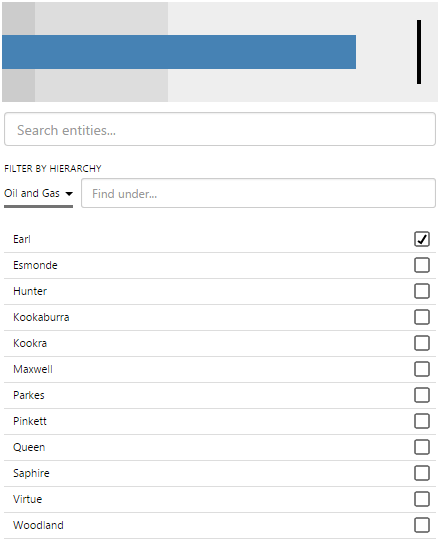Overview
The Bullet Graph is similar to a horizontal bar chart but allows users to compare two values in relation to one another. For example, an actual value (represented by a horizontal bar) and a target value (represented by a vertical line).
The following diagram shows a Bullet Graph being configured:
| Source Data: | The dataset from which the bullet graph sources its data. |
| Measure 1 Column - Measure 3 Column: | The Columns that provide values for up to three different comparative segments, each represented by a grey section. This can be used to specify different thresholds, such as good, OK, and bad. |
| Actual Column: | The column in the dataset that provides the actual value of interest. This is represented in the bullet graph by the blue horizontal bar. |
| Target Column: | The column in the dataset that provides the value that we are aspiring to reach. For example, a sales target. If the Actual Column is expressed as a percentage, Target Column is not required. This is represented in the bullet graph by the black vertical line. |
| Filter Column: | The column of the dataset that provides the values that will be assessed. This is used in conjunction with the Filter Value. |
| Filter Value: | The row of the dataset that provides the values that will be assessed. |
| Percent: | Select this check box if the Actual Column value is expressed as a percentage. |
| Reverse: | Select this check box to invert the Actual and Target Column values. |
Tutorial
The Bullet Graph is a useful component to display levels. In this topic, we’ll show you how to use the Bullet Graph to display actual vs planned production data for a selected well. This is often used in production summary reports. The background will be shaded to show the different measures.
Let’s look at how we’re actually going to do this, step-by-step.
Step by Step: Creating a Bullet Graph That Displays Target vs Planned
Before you start, open a new tab in Explorer and click the “Create a New Page in Studio Mode” thumbnail. Choose the grid layout – you can adjust the rows and columns if you like but it’s not important for this exercise.
You will need to adjust the configuration to suit your data at your site.
Step 1. Add the source data
Before we can display any data on the page, we need to add the source data.
- Below the canvas, click the button labelled “Add Data“.
- Choose the data you are going to use. For this tutorial, we are using a dataset called “WelPlanningData”.
- In the configuration options, specify the following:
- Name: WelPlanningData1 (this is automatically added)
- Query: WelPlanningData (this is the query in P2 Server that is being used to return the data)
- StartDate: (Datetime) 01/04/2015 12:00:00 AM
- EndDate: (Datetime) 30/04/2015 12:00:00 AM
- EntitiesList: (Event) selectedEntity
Step 2. Add the Bullet Graph
Drag and drop the Bullet Graph component onto a grid cell. The Bullet Graph is in the Chart ![]() group.
group.
Step 3. Configure the Bullet Graph
Configure the Bullet Graph as follows:
- Source Data: WelPlanningData1
- Measure 1 Column: (Text) OilP10
- Measure 2 Column: (Text) OilP50
- Measure 3 Column: (Text) OilP90
- Actual Column: (Text) OilActual
- Target Column: (Text) OilPlanned
Step 4. Add the Entity Selector
This step allows the user to select an entity, which will drive the meter indicator and measures.
- Drag and drop the Entity Selector control onto the canvas.
- Configure it as follows:
- Selected Entity: selectedEntity
- Selected Entities: (blank)
- Hierarchy Name: (Text) Oil and Gas
- Template Filter: (Text) Oil Producing Well
- Number of Selections: 1
Step 5. All done!
Congratulations! You now have a Bullet Graph that will show you actual vs planned oil production for a selected well.
- Click the preview
 button on the Studio toolbar to see what your page will look like in run-time.
button on the Studio toolbar to see what your page will look like in run-time. - Select different entities and observe the changes in the graph.
![]() Don’t forget to save your page!
Don’t forget to save your page!





